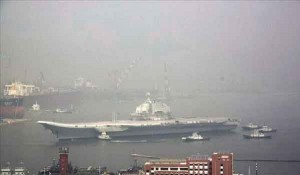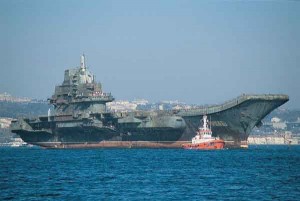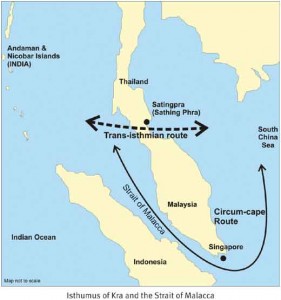“To win one hundred victories in one hundred battles is not the acme of skill. To subdue the enemy without fighting is the acme of skill.” —Sun Tzu, Art of War
The Chinese maintain that the trump card for winning a twenty-first century war is to combine Western technology with Eastern wisdom. Throughout the 1990s, Chinese geo-strategists espoused ‘shashoujian’ as the riposte to the US military in numerous articles. The Shashoujian – made popular by General Qin Shubao of the Tang Dynasty – is an ancient Chinese hand mace that could be concealed and employed without warning. The “Assassin’s Mace” thus entered lexicon as a Chinese stratagem of the relatively less powerful to humble the more powerful. One cannot but admire the majesty of the coinage!
The news of China’s retrofitted aircraft carrier Varyag sailing out of Dalian on August 10 last year for sea trials created a splash. The Varyag sortie came in the wake of recent Chinese iron-hand-in-velvet-glove assertiveness, turbo-charged military modernisation including its rapid induction of anti-access and area-denial – A2/AD – and subsurface warfare leviathans and its expansive claim over land and sea in its immediate periphery. Varyag might need another 18 months and some luck with the Shenyang J-15 jets to become fully operational. But the ripples generated by its maiden outing swelled into tidal waves, raising concerns amongst many as China’s empire-building is advancing apace. Varyag is likely to be rechristened “Shi Lang” after the Admiral who was responsible for the subjugation of Taiwan in 1681. The People’s Republic obviously knows how to semaphore its intent and then rub it in.
On November 14, 1910, Eugene Burton Ely accomplished the first shipboard take-off and landing in a Curtiss bi-plane from a makeshift deck on the American light-cruiser USS Birmingham, thus adding another dimension to air power and naval might. The day is not far when China too will savour its Eugene Ely-moment closing the gap in its power projection capability across the Asia-Pacific and the world beyond.
 The PLA Navy is likely to induct two, even three, indigenous aircraft carriers by 2025. Having gotten American carrier-centric fleets in the crosshairs of the land-based, 3,000-km range Dong Feng-21D Anti-Ship Ballistic Missile (ASBM), the Chinese pursuit of these game-changing strategic assets is an unambiguous signal to the US that the People’s Republic is very much in the game and would play by the rules it lays down.
The PLA Navy is likely to induct two, even three, indigenous aircraft carriers by 2025. Having gotten American carrier-centric fleets in the crosshairs of the land-based, 3,000-km range Dong Feng-21D Anti-Ship Ballistic Missile (ASBM), the Chinese pursuit of these game-changing strategic assets is an unambiguous signal to the US that the People’s Republic is very much in the game and would play by the rules it lays down.
 Having enhanced their outreach, the message for ‘upstart’ India is loud and clear – China shall not brook any challenges to its hard-earned hegemony.
Having enhanced their outreach, the message for ‘upstart’ India is loud and clear – China shall not brook any challenges to its hard-earned hegemony.
From Shashoujian to Shi Lang – The Beijing Build-up
Combining the aphorism ‘A chain is only as strong as its weakest link’ with acupuncture, their traditional system of medicine, the Chinese have created a blend of asymmetrical warfare known as “acupuncture warfare”. In fact, it dates back to the teachings of the old fox Sun Tzu and neatly conforms to the Chinese belief ‘The other side may be strong, but they are not strong in all things…’ Having adapted it to the modern times, acupuncture warfare aims to paralyse the ‘acupuncture points’ (weakest nodes) of the enemy’s Command, Control, Communications and Intelligence (C4ISR) framework. Acupuncture warfare is a way to throw a monkey wrench into a vastly networked military machine.
After the Third Taiwan Crisis (1995-1996), China fired hails of missiles to shake up Taiwan. The US responded by ordering a flotilla spearheaded by the USS Nimitz to patrol the Taiwan Strait. It was then that the People’s Liberation Army (PLA) went into a huddle to strategise and draw up a blueprint to checkmate the overwhelming military superiority of the US.
China believes that the trump card for winning a twenty-first century war is to combine Western technology with Eastern wisdom. Throughout the 1990s, in numerous writings, Chinese geo-strategists espoused ‘shashoujian’ as the riposte to the US military. The Shashoujian – made popular by General Qin Shubao of the Tang Dynasty – is an ancient Chinese hand mace that could be concealed and employed without warning. The “Assassin’s Mace” thus entered the Chinese lexicon as a stratagem of the relatively less powerful to humble the more powerful. One cannot but admire the majesty of the coinage!
 The primitive-sounding shashoujian is in fact a state-of-the-art super weapon, nay a quiver of weapon systems. Among the capabilities associated with the shashoujian are:
The primitive-sounding shashoujian is in fact a state-of-the-art super weapon, nay a quiver of weapon systems. Among the capabilities associated with the shashoujian are:
- Anti-satellite (ASAT) weapons
- Spaced-based Reconnaissance, Surveillance and Target Acquisition (RSTA)
- Electro-magnetic weapons
- Advanced fighter aircraft & Airborne Early Warning platforms
- UAVs & UUVs
- Killer submarines
- Sea mines
- Electronic warfare
- Over-the-horizon radars
- Lethal ballistic and cruise missiles
- Integrated air defence systems
- Cyber warfare
A Deadly Arsenal! In the ninth century, Chinese alchemists discovered gunpowder which revolutionised warfare. Now, the Chinese regard the tools of A2/AD as the new gunpowder. China will rely on its goodly A2/AD and sub-surface warfare capabilities to take on America’s air and naval might in the Asia-Pacific theatre. For this, the PLA Navy has embarked on force restructuring and massive force expansion to have about 300 combat vessels including 70 submarines and at least two medium-sized carriers by 2025. Given the present day budgetary constraints, the US Navy armada in the ‘Western Pacific Theatre of Operations’ is likely to stagnate at the current force levels. By 2025 or earlier, the PLA Navy could well match the US Navy numerically.
How would the “shashoujian” work in the Asia-Pacific theatre? In any future conflict, the PLA aims to diminish the power asymmetry by seizing sea control through lightning blows of sea denial and ‘blinding’. Sea denial will be achieved through A2/AD instruments such as salvoes from submarines, blitz of ASBMs and aircraft/submarine-launched sea-skimming Anti-Ship Cruise Missiles (ASCMs) and peppering of DH-10 air-launched, land-attack cruise missiles from Xian H-6K bombers. The PLA will be in a position to target and assault forward bases in Guam and Okinawa and the US Carrier Battle Groups who, due to the short range of the strike warplanes aboard the US carriers will be forced to close in and thus become sitting ducks for the surface-based anti-ship missiles. The PLA expects to paralyse the American networks through pre-emptive ‘blinding’ of information and communication systems using ASAT weapons, electro-magnetic and cyber warfare, to leave the C4ISR architecture in utter disarray. Clever as they come, to keep everybody guessing, the PLA has not defined the tipping point or ‘what’ will provoke them to unleash the “shashoujian.”
Having sensed the gentle tilting of balance of power, like a bull in a china shop, the cocksure PLA has begun to snort and storm. China couches its outlandish claim of territorial waters as ‘historic waters’ dating back to the 1930s when Chiang Kai-shek, then generalissimo, was reigning over the Middle Kingdom. The Kuomintang (his Chinese Nationalist Party) drew a dotted line in the shape of a cow’s tongue, from the East Sea spanning across the South of China, enveloping as much sea and archipelagos, including the island chains of the Paracels (Vietnam) and the Spratlys (Philippines). Add South Korea (Ieodo Island a.k.a. Socotra Rock) and Japan (Caprine islands called Senkaku) also to the list of aggrieved parties, and we have a region trembling in fear of the rapacious Dragon. Of course, China is ever ready to resolve the long-festering disputes but only to its sole satisfaction!
This unwarranted aggression has destabilised the regional security setting, triggering off an arms race in East Asia-Pacific. By stoking up the smouldering sores, China has only succeeded in shoving its neighbourhood into American hands. The US and her allies have their hands full yet they have to take the bull by the horns to play the new Great Eastern Game.
The Original Empire Strikes Back
With the Americans being aware of the Beijing build-up, and episodes of Sino-US naval argy-bargies – USNS Impeccable incident for instance, their think tanks have been burning the midnight oil. In May 2010, the Washington DC-based Centre for Budgetary and Strategic Assessments (CBSA) released the conceptive document Air-Sea Battle: A Point-of-Departure Operation Concept, a newly minted blueprint to head off Beijing.
Is Air-Sea Battle (ASB) the antidote to China’s venom poisoning the region? CSBA swears ASB, which has earned the nod of both US Navy and Air Force, is not about war with China or containment of China. It is part of a larger ‘offsetting strategy’ aimed at preserving a stable military balance in those areas that are both vital to US interests and where Chinese A2/AD capabilities are being fielded. That, in a few words, is maintaining the stability in East Asia.
The purpose of ASB, in American perception, is to discourage acts of coercion or aggression and promote change through internationally accepted norms. Translated into Mandarin, it reads, “Should China choose war, it will fail to realise its objectives through military adventurism.” In East Asian lingo, it says, “Sleep well for the US will intervene effectively.” A bigger bomb for bomb, a bigger missile for missile – in case China used the military stick as an instrument of conflict resolution. That is, ASB is a confidence-builder for smaller regional players; should Big Brother China turn belligerent, dial Bigger Brother Uncle Sam, and he will steam in to boot out the interloper.
How does ASB help to offset China and reassert sea control? Let us rewind to the eighties. Disturbed by the quantum leaps made by the USSR military in both numbers and firepower in the late 1970s, the US Army and Air Force racked their brains to face-up to the tilting balance of conventional power. This begat the offensive Air-Land Battle manual that advocated on expanding the capabilities to ‘see deep’ and ‘shoot deep’. It enjoined both the US Army and Air Force onto synergistic use of firepower to assault the enemy simultaneously at the vanguard as well as the rearguard. ‘Jointness’ became the fulcrum of military action. The induction of next-generation of Intelligence, Surveillance and Reconnaissance (ISR) elements gave new edge to the sword-arm, and Air-Land Battle, which formed the basis of US military’s European war-fighting doctrine from 1982 to the late-1990s, transmuted warfare into a new realm where synergy and swiftness mattered as much as aggressive tactics.
The crux of the ASB is to ensure that the US military, without upsizing and reconciling to the steady veering of power dynamics, remains a highly credible deterrent force to compel the People’s Republic to shun adventurism and expansionism. ASB does not aim to upturn the Chinese juggernaut, just to apply the brakes.
| Editor’s Pick |
Like Air-Land Battle, ASB calls for greater and seamless collaboration between the US Navy and the US Air Force. Like any war doctrine, ASB too hinges on repelling the Chinese first strike followed by seizing the initiative to dictate subsequent course of events. The ASB response will focus on dismantling China’s A2/AD capabilities and crippling the sub-surface forces.
Seeking to impair Chinese A2/AD assets through ‘blinding’ onslaughts on C4ISR facilities, the ASB plans to achieve through concerted cyber attacks as well as destruction of satellites using ballistic missiles and directed-energy weapons and jam the radio waves. The US Navy and Air Force combat aircraft are to be tasked to eliminate the missile launchers, missile boats and Airborne Early Warning and Control (AEW&C) platforms. The US Navy’s destroyers equipped with Aegis Combat System, are to be tasked for the defence of bases and ships.
As for the submarines of the PLA Navy, , the Anti-Submarine Warfare (ASW) force including stealth bombers, armed-UUVs and Crafts Of Opportunity (COOP), are to be tasked to confine the undersea vessels to littoral waters and within the anti-submarine barriers demarcated along the Ryukyu Islands and the Luzon Strait.
Looming Dragon, Slouching Tiger
India has always taken for granted that the Indian Ocean is her mare clausum and exclusive sphere of influence but expansionist China has thrown down the gauntlet. Analysts term it the ‘String of Pearls’ encirclement strategy. Whatever you call it, the PLA idea is uncomplicated and cost-effective – constrict India to minimise her influence in the Indian Ocean Region (IOR) and manipulate cat’s-paw Pakistan to rivet the Indian armed forces’ glare on the hatchet nation.
The nuts and bolts of the so-called ‘String of Pearls’ strategy of forward bases has been dissected threadbare. China’s naval and maritime doings – building related infrastructure in Pakistan, Myanmar and Sri Lanka; submarine base at Marao Islands in the Maldives, also meant to keep tabs on the US forces based in Diego Garcia, the US military outpost in the Indian Ocean; warships patrolling in the Gulf of Aden to bear hard on piracy; obtaining exclusive rights to prospect the international seabed area of 10,000 square kilometres in the IOR for rare earth like polymetallic sulphide – give credence to their IOR rush. China’s plans speak for themselves.
To fuel its industrial growth, the People’s Republic needs humongous feedstock and hydrocarbons, much of which have to voyage through the Indian Ocean. Unfortunately, miles of railroads and pipelines through Pakistan, Bangladesh and Myanmar cannot substitute sea-borne haulage. Of course, the Thai canal, from the Andaman Sea to the South China Sea slicing through the Isthmus of Kra in southern Thailand, will be able to shrink time and distance but Thailand has not rolled up its sleeves. Geography can be a nasty leveller.




